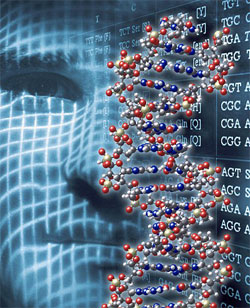Scientists Find 19 Pieces of Non-Human DNA in the Human Genome
 The latest study on the subject of human DNA reveals some startling facts which can shed a new light on our entire organism. According to the study’s finding, published in the Proceedings of the National Academy of Sciences, 8% of our DNA is alien, consisted of non-human viral fragments.
The latest study on the subject of human DNA reveals some startling facts which can shed a new light on our entire organism. According to the study’s finding, published in the Proceedings of the National Academy of Sciences, 8% of our DNA is alien, consisted of non-human viral fragments.
The group of scientists from Tufts and University of Michigan Medical School examined 2500 people in their study and revealed that there is non-human DNA within our human genome. According to the experts, our DNA is not entirely human and our genome contains as much as 19 pieces of Ancient Viral DNA.
What’s even more startling, experts discovered the full genetic mockup for an entire virus within 2% of the people they examined. Sciencedaily.com reports that it’s still unknown if the virus can be replicated or reproduced but if we take into account other studies of ancient virus DNA it can be concluded that it can significantly affect the humans who carry it.
ScienceDaily continues to say that the study sheds new light on human endogenous retroviruses (HERV). If you haven’t heard about HERV you should know that they are actually antique diseases with unbelievable similarity with the human immunodeficiency virus, the precursor to AIDS.
According to experts this newly discovered Viral DNA0 is believed to have been transferred through thousands of generations, from generation to generation and has somehow managed to survive until modern day. Further research needs to be done so that the study’s authors can be able to determine with certainty if these ancient strains of DNA could cause infections.
Senior author and virologist John Coffin, Ph.D. of the Tufts University School of Medicine says: “This one looks like it is capable of making infectious virus, which would be very exciting if true, as it would allow us to study a viral epidemic that took place long ago. This research provides important information necessary for understanding how retroviruses and humans have evolved together in relatively recent times.”
Co-first author Zachary H. Williams, a Ph.D. student at the Sackler School of Graduate Biomedical Sciences at Tufts University in Boston adds: “Many studies have tried to link these endogenous viral elements to cancer and other diseases, but a major difficulty has been that we haven’t actually found all of them yet. A lot of the most interesting elements are only found in a small percentage of people, which means you have to screen a large number of people to find them.”
Co-first author Julia Wildschutte, Ph.D., who began the work as a Ph.D. student in Coffin’s lab at Tufts says: “This is a thrilling discovery. It will open up many doors to research. What’s more, we have confirmed in this paper that we can use genomic data from multiple individuals compared to the reference human genome to detect new HERVs. But this has also shown us that some people carry insertions that we can’t map back to the reference.”
yogaesoteric
March 9, 2017
